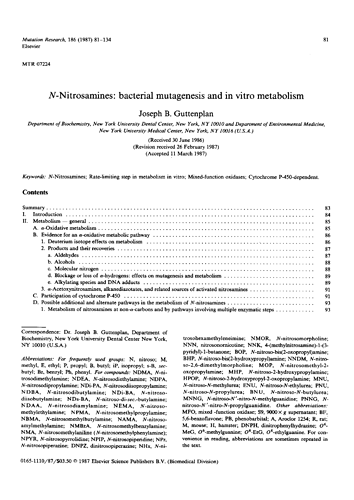If you truly want to understand Mutagenesis by Nitrosamines, Relationship between metabolism and mutagenesis, factors that optimize mutagenesis by Nitrosamines, SAR relationship in mutagenesis… Please read this whole 54 pages article published by Dr. Guttenplan
N-Nitrosamines bacterial mutagenesis and in vitro metabolism.pdf (4.7 MB)
4 Likes
While this is an important historic work it is dated and incomplete. It focuses on small nitrosamines and not the API-related nitrosamines today nor work on tobacco nitrosamines that was done by Hecht, and theses of Carlson, and Peterson. Consequently, discussion of metabolism by CYPs other than 2E1 are missing as well as effects of physicochemical properties and chemistry of nitrosamines, etc. SAR relationships have been expanded on as well; see my paper Developing structure-activity relationships for N-nitrosamine activity - ScienceDirect for more recent work. For other recent work on SAR relationships for establishing AI limits see the recent Dobo paper: https://pubs.acs.org/doi/pdf/10.1021/acs.chemrestox.1c00369
4 Likes
To understand the mutagenesis of nitrosamines (after you understand the competing phase 1 and 2 metabolism pathways) you also have to understand the DNA adducts formed, the DNA adduct profile, and which adduct-bases are mutagenic and which are not as well as which adducts are cytotoxic versus mutagenic. Of course you also need to know the appropriate DNA repair mechanism for your adducts and the DNA repair capacity in the species and tissues of interest. See: Do dose response thresholds exist for genotoxic alkylating agents? - PubMed and for two very recent papers see: IJMS | Free Full-Text | Metabolic Activation and DNA Interactions of Carcinogenic N-Nitrosamines to Which Humans Are Commonly Exposed and IJMS | Free Full-Text | Metabolism and DNA Adduct Formation of Tobacco-Specific N-Nitrosamines
5 Likes
@kpcross Thanks so much for your openness and for providing those insights and references. There is still a lot for us non-toxicologists to learn and understand when it comes to mutagenicity and metabolism of Nitrosamines. We are lucky to count on experts like you that can help us understand all this.
@Naiffer_Host probably could be good if we can organize a webinar with @kpcross to have a first view of this nice work, be able to ask questions and discuss about the topic.
I’ll be happy to coordinate that with @kpcross . I suggest to start by watching his recorded presentation from our USP-Sindusfarma Workshop (3:52:40), as well as @David (3:30:08)
1 Like
Re-taking this after quite a long time. I guess that vacation period was not helping me. Thanks Naiffer.
Looking at the constant requests for having more knowledge to the nitrosamine compounds, originators and possible substructures generated, I still believe that a round table could be a good activity to organize by the USP on this topic. The audience should be open not only to the members of the group.
I´m open to help in the organization.
1 Like
What is FDA’s expectations about in vitro metabolism data in the statement “In addition to the enhanced Ames test, the Agency is currently requesting a second in vitro mammalian cell mutation assay and in vitro metabolism data (including human hepatocyte or microsome) to support an AI limit of 1500 ng/day”? Are they referring to metabolic activation assays, metabolite profiling?
Would really appreciate feedback. thank you
1 Like
I have the same question as nilubiswas, as we’ve detected N-nitroso-dorzolamide in one of our products and would like to adjust the AI to the EMA’s recommended value of 1500 ng/day.
Has anyone had experience with this and can share their insights?
1 Like
@romnaiffer any advice on this?
